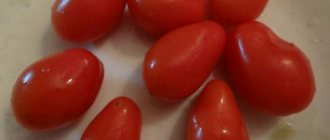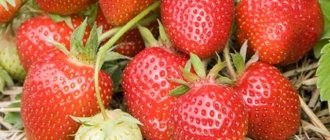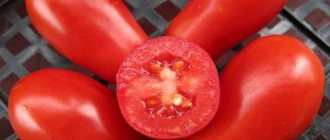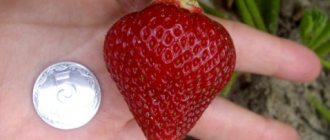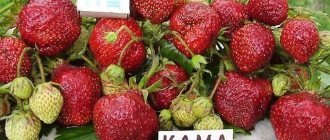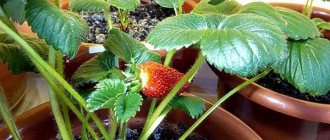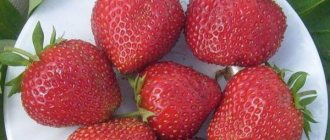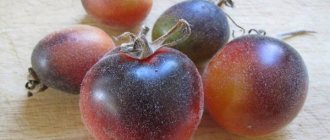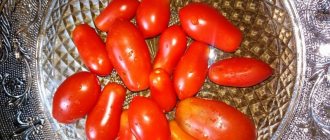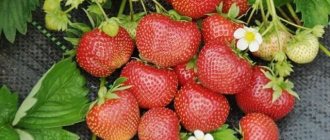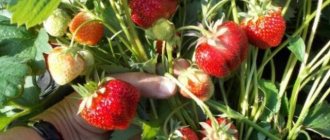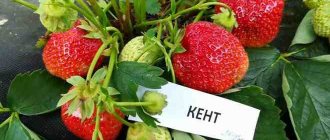Description of culture
A remontant medium-sized hybrid does not take up much space on the site, since the bushes are compact, the stems do not extend above 40 cm, and the leaves are located close to each other. The Moscow Delicacy variety is not characterized by abundant mustache formation .
Description of the plant:
- leaf blades are rich green, slightly pubescent;
- stems are thin, hard, pale green;
- the root system is developed, reaches a depth of 7 cm, the roots spread evenly in different directions;
- flowers are hidden under leaves;
- the fruit is cone-shaped, with a blunt apex, weighs about 60 g;
- the surface of the berry is smooth, red, with light brown achenes visible on it;
- the pulp is sweet, without cloying, with slight sourness, tasting score - 4.7 points.
Advantages and disadvantages, differences from other varieties
Despite the word “delicacy” in the name of the variety, it is not at all difficult to grow, and this is far from its only advantage. The peculiarity of the variety is, perhaps, that the fruits really resemble peppers, and their taste is not purely “tomato.” The undoubted advantages of the Moscow delicacy tomato are:
- spicy taste;
- original shape of the fruit;
- good yield, with careful care;
- good transportability and long-term storage of the crop;
- increased disease resistance;
- ease of care.
However, picky summer residents dispute at least two points on this list. Thus, some consider the need to form a bush to be a disadvantage, although this has to be done in the case of most varieties and hybrids of tomatoes, especially indeterminate ones. Not everyone likes the shape of the fruit either; some prefer the “classic”. Well, this is from the category of “taste and color”. But what is really unpleasant is the susceptibility to late blight, which forces in many regions to carry out preventive spraying, or even refuse to grow this tomato in unprotected soil.
The Moscow delicacy is not a first-generation hybrid, and if you wish, you can collect seeds from your harvest for subsequent sowing in subsequent years. It produces few seeds, but two or three tomatoes, fully ripe on the bushes, will be enough for several years.
Of course, you can find many analogues of this variety among the thousands available, depending on the selected trait. Most of the available varieties are used for salad purposes, almost half have an excellent fruit taste, many have a cylindrical or plum-shaped shape. There is also just a variety called “Delicacy”. True, the name it received is not entirely appropriate: the taste of the fruit is rated only as good.
There is a similar variety called Italian Delicacy, which is mostly used for canning. The Salted Delicacy variety has a similar purpose. The hybrid Raspberry delicacy, used as a salad, is characterized by the excellent taste of large fruits. In general, we can assume that complete analogues of the Moscow delicacy, including shape, color, and technical characteristics, apparently do not exist.
Tomato Pickling delicacy is a little similar to the variety in question, but its purpose is different
Characteristics of strawberries Moscow delicacy
Remontant strawberries with neat bushes and large fruits grow both in greenhouse conditions and in open ground. The plant lives and bears fruit for up to 5 years.
Flowering period, ripening time, yield
Strawberries, a Moscow delicacy, bloom at the end of May. Plants that receive quality care produce their first harvest of the season in early June. The second batch of berries can be collected in August.
The second yield is higher, accounting for about 70% of the total harvest for the season. One bush per year produces up to 1.2 kg of fruit.
The berries are well stored and do not lose their marketability during long-term transportation, which is why many farmers grow Moscow delicacy strawberries for sale.
Application area
The berries are suitable for fresh consumption and for cooking:
- jam;
- fruit salad;
- compote;
- dessert pastries;
- berry ice;
- vitamin cocktails.
For long-term storage, strawberries are frozen.
Resistance to diseases and pests
The Moscow Delicacy variety is characterized by fairly strong immunity. With proper care and adherence to the watering regime, the roots are not affected by fungal infection, and above-ground shoots are not affected by insect pests.
See also
Description and characteristics of the Marshall strawberry variety, cultivation and careRead
a brief description of
Malga is suitable for commercial cultivation and small personal gardens. The variety showed excellent qualities when tested under continental climate conditions in its homeland, in mountainous and lowland regions. This strawberry has many positive qualities.
Advantages of the variety
- high productivity;
- continuous fruiting;
- large fruits that do not become smaller by the end of the season;
- the taste is pleasant, sweet and sour, with a strawberry aroma;
- maintains its presentation during transportation;
- can be grown in open/indoor ground;
- does not bake in the sun;
- good immunity to diseases;
- resistance to the vagaries of weather;
- multiple powerful peduncles;
- good regeneration after sanitary pruning.
Disadvantages of the variety
The variety has just begun its march across the planet, so far only two shortcomings have been found:
- very few whiskers, making active reproduction difficult;
- productivity depends on the quality of fertilizing;
- sweet and sour taste, especially when the weather is rainy or planted in the shade;
- weak resistance to anthracnose.
Gardeners are delighted with Malga. If you follow all agrotechnical measures, you can get a very high yield of delicious, beautiful berries.
Main positive and negative aspects
The Moscow Delicacy variety has been popular among gardeners for a long time. Its main advantages:
- early ripening;
- high productivity;
- transportability;
- the possibility of growing all year round, in the warm season - in open ground, in the cold season - in a greenhouse;
- resistance to most pathologies characteristic of berry crops.
The disadvantages include:
- the need to cover the plantation for the winter;
- weak formation of whiskers (one whisker per 6-8 plants);
- the need to update the plantation every 4-5 years.
Popular sections
Description of strawberries Homemade delicacy F1
Strawberry Home Delicacy F1 is a remontant, large-fruited hybrid that begins to ripen two weeks earlier than other varieties. Harvesting begins 4-6 months after sowing and continues until the end of September. The plants are particularly strong and highly productive. They produce very tasty, large berries with a dense consistency. Productivity up to 0.8-1.5 kg per bush. Long flower stalks make it easier to pick berries and add additional decorative value to plants on balconies, in containers and hanging pots. We recommend cultivation for experienced gardeners. The seeds of large-fruited strawberries and wild strawberries are difficult to germinate. When sowing strawberry seeds, you need to know that they have a low germination rate (50-60%). Therefore, it is necessary to strictly observe the sowing regime.
Strawberry agricultural technology Homemade delicacy F1
Sowing strawberry seedlings Homemade delicacy F1 - slow-germinating, sown on the surface of moist sterile soil, under glass or film. It is necessary to regularly ventilate the crops, avoiding the accumulation of condensation. Germination is 3-4 weeks at a temperature of 20-22°C. Picking in the phase of 1-2 true leaves. Care: timely watering, not allowing the earthen ball to dry out, fertilizing once a week with balanced fertilizer. In winters with little snow and harsh winters, it is recommended to cover berry plantings with spruce branches or dry leaves.
Video about strawberries Homemade delicacy F1
It should be remembered that remontant strawberries are capable of quickly drawing out the main nutritional components from the soil, so growing this berry crop in the same area for more than four years is not advisable.
Advice from TomatoTomatoes:
According to reviews from amateur gardeners, Home Delicacy F1 is one of the largest and tastiest hybrids of large-fruited remontant strawberries. Plants of this hybrid are characterized by high productivity.
«>
Subtleties of growing varieties
In each region, the planting time is determined by weather conditions, but strawberries are planted only after the soil has warmed to +18 °C.
When forming a strawberry plantation, it is important to consider crop rotation. The best area for strawberries is where they used to grow:
- green manure (it is advisable to embed them in the soil when digging);
- leguminous plants;
- garlic, onion;
- roots.
You cannot plant strawberries in an area where nightshades grew. These crops have similar diseases.
Selecting the best seedlings for planting
Seedlings should be purchased from a nursery, not from hand. High-quality planting material has not only last year’s foliage, but also at least two young leaves. The leaf blades are rich in color, slightly pubescent, without deformation or signs of disease. The thickness of the lower part of the stem should be about 0.7 cm. The root system of development, the roots are elastic, flexible, moist, without signs of damage by insects.
Before planting, it is advisable to disinfect the roots: dip them in a pale manganese solution for 15 minutes.
Selecting a landing site
Strawberries should grow in a sunny place. The plantation is set up in the southern part of the garden. The place should be elevated, protected from strong winds. It is unacceptable to plant in lowlands, where there is a high probability of rotting of roots and shoots due to high humidity.
The soil in the selected area is prepared 2 weeks before planting:
- dig up;
- remove weeds;
- add organic matter and sand in a ratio of 2:1.
Landing technology
Planting strawberries is carried out according to the following algorithm:
- planting holes are made at a distance of 40 cm from each other;
- to save space and make further maintenance easier, planting is carried out using the two-row method (the distance between rows is 20-25 cm, between stripes - 60 cm);
- pour a little ash into the holes (it will speed up rooting);
- The plant is carefully placed in the hole, covered with soil, and watered.
Nuances of crop care
Strawberries Moscow delicacy are not capricious, but there are certain nuances of cultivation. One of the main features of the variety is extreme sensitivity to waterlogging of the soil, so watering control must be careful.
If there is excess moisture, the surface of the berries cracks. With a lack of moisture, the taste of the fruit deteriorates.
Watering frequency
The first days after planting, strawberries are watered daily, but moderately. Use lukewarm water. After rooting, watering is reduced and its frequency is adjusted to weather conditions. If there are hot days without precipitation, then water 3 or 4 times a week.
See also
When and how to prune strawberries correctly, timing and step-by-step instructionsRead
Fertilizers and fertilizers
Fertilizing strawberries is carried out according to the following scheme:
- at the beginning of the growing season, the ground is watered with ammonia to accelerate the development of greenery;
- During the flowering phase, potassium fertilizer is added; the use of organic matter and ash is acceptable;
- to increase the number of inflorescences, spray with a solution of boric acid (a teaspoon of the substance per 10-liter bucket of water);
- The development of strawberries is positively influenced by the addition of manure infusion.
With an excess of nitrogen in the soil, strawberries produce small and sour fruits.
Preparing for winter
The Moscow Delicacy variety is characterized by low frost resistance. Therefore, for the winter, the plantation must be covered with agrofibre or other insulating material. Some summer residents put spruce paws on the bushes, pour soil on top, and in winter add more snow.
Before winter insulation, strawberries are pruned and leaf litter is raked. The soil is treated with drugs to prevent infection.
Growing and care
Garden strawberries, a Moscow delicacy, bear fruit from early summer to late autumn. This obliges the gardener to pay attention to it all season. Otherwise, high productivity will not be achieved.
Watering
Despite the high demands on moisture for the Moscow Delicacy variety, too much watering is undesirable. Fungal infections develop more actively in beds where there is prolonged stagnation of moisture. In general, the variety belongs to the assortment resistant to gray rot.
Warm water is used for irrigation. In hot weather, the procedure is carried out every 3 days, early in the morning or in the evening. If possible, it is better to irrigate using the drip irrigation method.
Loosening, weed control
Such agrotechnical technique as loosening should not be neglected. The supply of oxygen is important for the root system. During loosening, weed growth is disrupted and moisture is maintained at an optimal level. Loosening should not be deep (no more than 3-4 cm, otherwise there is a risk of damaging the root system). Using mulch makes the gardener's task easier. For these purposes, straw, rotted manure, leaf litter or black agrofibre are used.
Removing a mustache
The Moscow Delicacy variety produces a lot of whiskers. Some of the first-order rosettes are left for reproduction, the rest of the mustaches are promptly removed.
Top dressing
Feeding begins in early spring. Nitrogen-containing mixtures will help the bushes grow. As for mineral fertilizers, you can use urea from organic mullein or bird droppings diluted with water in a ratio of 1:10 or 1:20, respectively. Closer to the beginning of flowering, fertilize with complex mineral fertilizers with potassium and phosphorus. In mid-summer, the soil is fertilized with organic matter (a bucket per m2).
Feeding the leaves with solutions containing boron brings good results. Boron promotes the formation of ovaries, prevents the inflorescences from falling off, and accordingly, the yield increases. 5 g of boric acid is diluted in 10 liters of water. There are reviews from gardeners that fertilizing with boron can lead to rot of the root system, so it is better to experiment with several bushes and, if the result is positive, replicate the experience throughout the entire berry garden.
Gardeners also use nettle infusion to improve the productivity of bushes. Fill two thirds of a large container with herbs, add water and leave for a week, stirring occasionally. Then dilute 1:3 and water the beds. Each bush should receive 1 liter. solution.
Pest and disease control
To prevent infections with infectious diseases, strawberries are sprayed before flowering with a 1% solution of Bordeaux mixture. Prevention of the fight against various ailments is compliance with crop rotation. You cannot plant strawberries after potatoes and tomatoes. But legumes and garlic as predecessors are considered one of the best. If slugs or spider mites are noticed in the area, use the Actellik insecticide.
Folk remedies help successfully fight infections and pests. Mustard powder is scattered between the strawberry bushes 2-3 times a season. Mustard can be alternated with tobacco dust.
Preparing for winter
Before covering the bed, it is necessary to trim the old foliage (green leaves are not trimmed) and clean the area of debris.
The variety has average frost resistance, so in the risky farming zone, strawberries need to create reliable protection from freezing of the root system. They use mulching with compost, covering with pine spruce branches, cardboard, and agrofibre. In winter, snow is additionally shoveled.
Reproduction
The Moscow delicacy is a hybrid, which means it is useless to take seed material from the fruit. Parental varieties are needed for pollination. To update the plantings, the gardener needs to take sockets from the most successful bushes, divide the bushes or buy seeds.
Rosettes are formed in the greatest number on annual bushes, so the preparation of planting material must be planned in advance. Root rosettes in plastic pots to obtain seedlings with a closed root system. For division, select non-overgrown specimens no older than three years of age. There is no point in dividing lignified roots.
Seeds are sown in early February. Plants are planted in a greenhouse when two true leaves appear. They are planted in an open area after the soil has warmed up.
Diseases and pests
The Moscow Delicacy variety is immune to infection and insects. But sometimes strawberries are affected:
- Strawberry mites that can devastate a berry garden in two years. These insects lay eggs on the underside of leaf blades. They live where warmth is combined with high humidity. Symptoms of damage include drying out of shoots and the formation of small dry fruits. They fight the pest with insecticides. For prevention, treat the berry garden with Bordeaux solution, pull out the weeds in a timely manner, and loosen the soil after harvesting.
- Nematodes. Symptoms: drying of berries before ripening. A plant affected by worms will have to be dug up by the roots and destroyed, otherwise the pest will spread to other bushes.
- Fungal infection. To prevent it, the area is treated with a solution of copper sulfate every season in early spring and autumn.
Features of the hybrid and its characteristics
“Moscow delicacy” is known and grown by many gardeners, and the reviews about this variety are very positive. It belongs to day-neutral plants and is able to develop and successfully form berries even in conditions of a shortened daylight period.
Only the most flattering statements can be heard about the remontant hybrid “Moscow Delicacy”, bred in Holland, because it produces several harvests per season. The duration of its fruiting lasts from the end of June to the end of September.
Note! After two years, the hybrid is able to grow both in garden beds and at home as a potted crop. In other words, “Moscow delicacy” is a strawberry ready to bear fruit throughout the year.
Description of the appearance of the plant
- Strawberries have fairly compact bushes closer to medium size, although with good care the bushes become quite voluminous and large.
- There are many leaves in the bush, they have a bright green color, with distinct teeth visible along the edges of the leaves.
- The stalks on which the ovaries are formed are strong and long.
- The semi-spreading inflorescences are located high above the leaves.
- Each inflorescence has a huge number of white flowers, in which a yellow core is visible, this is where the formation of ovaries and the formation of fruits occurs. Strawberries of this variety have almost no empty flowers.
- The hybrid almost does not form a mustache.
- An interesting feature of the variety is the ability to form peduncles in a rosette, in the absence of a full-fledged root system.
